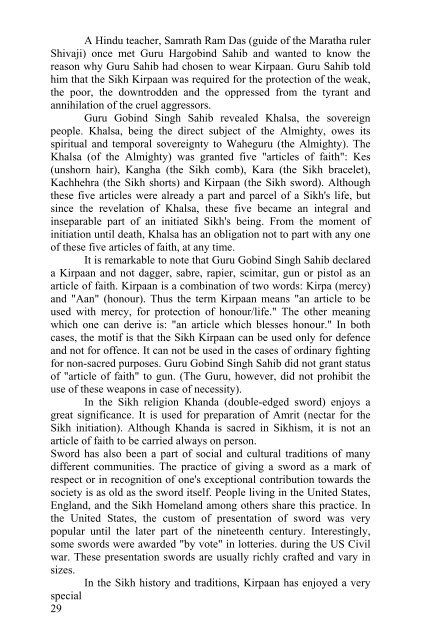HOW EUROPE IS INDEBTED TO THE SIKHS ? - Global Sikh Studies
HOW EUROPE IS INDEBTED TO THE SIKHS ? - Global Sikh Studies
HOW EUROPE IS INDEBTED TO THE SIKHS ? - Global Sikh Studies
Create successful ePaper yourself
Turn your PDF publications into a flip-book with our unique Google optimized e-Paper software.
A Hindu teacher, Samrath Ram Das (guide of the Maratha ruler<br />
Shivaji) once met Guru Hargobind Sahib and wanted to know the<br />
reason why Guru Sahib had chosen to wear Kirpaan. Guru Sahib told<br />
him that the <strong>Sikh</strong> Kirpaan was required for the protection of the weak,<br />
the poor, the downtrodden and the oppressed from the tyrant and<br />
annihilation of the cruel aggressors.<br />
Guru Gobind Singh Sahib revealed Khalsa, the sovereign<br />
people. Khalsa, being the direct subject of the Almighty, owes its<br />
spiritual and temporal sovereignty to Waheguru (the Almighty). The<br />
Khalsa (of the Almighty) was granted five "articles of faith": Kes<br />
(unshorn hair), Kangha (the <strong>Sikh</strong> comb), Kara (the <strong>Sikh</strong> bracelet),<br />
Kachhehra (the <strong>Sikh</strong> shorts) and Kirpaan (the <strong>Sikh</strong> sword). Although<br />
these five articles were already a part and parcel of a <strong>Sikh</strong>'s life, but<br />
since the revelation of Khalsa, these five became an integral and<br />
inseparable part of an initiated <strong>Sikh</strong>'s being. From the moment of<br />
initiation until death, Khalsa has an obligation not to part with any one<br />
of these five articles of faith, at any time.<br />
It is remarkable to note that Guru Gobind Singh Sahib declared<br />
a Kirpaan and not dagger, sabre, rapier, scimitar, gun or pistol as an<br />
article of faith. Kirpaan is a combination of two words: Kirpa (mercy)<br />
and "Aan" (honour). Thus the term Kirpaan means "an article to be<br />
used with mercy, for protection of honour/life." The other meaning<br />
which one can derive is: "an article which blesses honour." In both<br />
cases, the motif is that the <strong>Sikh</strong> Kirpaan can be used only for defence<br />
and not for offence. It can not be used in the cases of ordinary fighting<br />
for non-sacred purposes. Guru Gobind Singh Sahib did not grant status<br />
of "article of faith" to gun. (The Guru, however, did not prohibit the<br />
use of these weapons in case of necessity).<br />
In the <strong>Sikh</strong> religion Khanda (double-edged sword) enjoys a<br />
great significance. It is used for preparation of Amrit (nectar for the<br />
<strong>Sikh</strong> initiation). Although Khanda is sacred in <strong>Sikh</strong>ism, it is not an<br />
article of faith to be carried always on person.<br />
Sword has also been a part of social and cultural traditions of many<br />
different communities. The practice of giving a sword as a mark of<br />
respect or in recognition of one's exceptional contribution towards the<br />
society is as old as the sword itself. People living in the United States,<br />
England, and the <strong>Sikh</strong> Homeland among others share this practice. In<br />
the United States, the custom of presentation of sword was very<br />
popular until the later part of the nineteenth century. Interestingly,<br />
some swords were awarded "by vote" in lotteries. during the US Civil<br />
war. These presentation swords are usually richly crafted and vary in<br />
sizes.<br />
In the <strong>Sikh</strong> history and traditions, Kirpaan has enjoyed a very<br />
special<br />
29

















